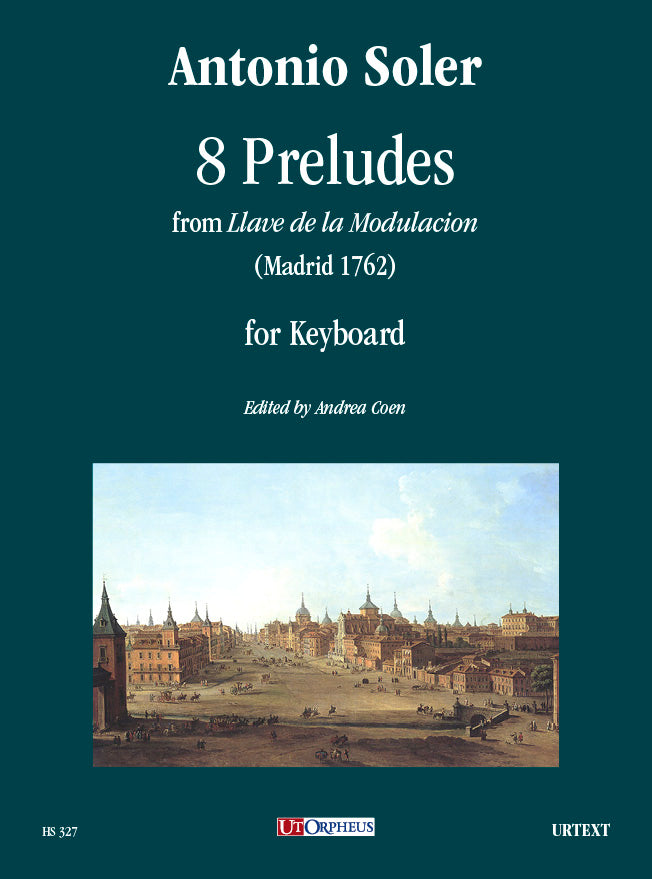Soler: 8 Preludes from "Llave de la Modulacion"
Expected to ship in 1-2 weeks.
- Composer: Antonio Soler (1729-1783)
- Instrumentation: Keyboard
- Work: 8 Preludes from Llave de la modulación (The Key to Modulation) (1762)
- ISMN:
- Size: 9.1 x 12.2 inches
- Pages: 20
Description
In 1716, François Couperin published in Paris "L'Art de Toucher le Clavecin", that brief and famous method containing eight Preludes, all extraordinarily beautiful, as well as technically very useful. Less than fifty years later, in 1762 in Madrid, Padre Antonio Soler published through Joachin Ibarra a weighty treatise of 272 pages ("Llave de la Modulacion"), which includes – in the tenth and final chapter – eight Preludes for keyboard instrument.
This kind of Prelude, according to what emerges from the thorny and at times ambiguous language of Padre Soler, while maintaining its undoubted basic executive value, stands on the one hand as a study of composition and on the other as an exercise in improvisation. Both these categories are more than pertinent to the period in which this work was conceived and to its aesthetics. in this sense, the term "arbitri" itself, so widely used in the musical text, is perhaps the most representative of a type of training that is actually centred more on practice procedure than on merely theoretical study.
Publishers use a lot of words to describe what they sell, and we know it can be confusing. We've tried to be as clear as possible to make sure you get exactly what you are looking for. Below are descriptions of the terms that we use to describe the various formats that music often comes in.
Choral Score
A score for vocalists that only contains the vocal lines. The instrumental parts are not there for reference. Generally, cheaper than a vocal score and requires multiple copies for purchase.
Facsimile
Reproductions of the original hand-written scores from the composer.
Full Score
For ensemble music, this indicates that the edition contains all parts on a single system (there are not separate parts for each player). In larger ensembles, this is for the conductor.
Hardcover
Hardbound. Generally either linen-covered or half-leather.
Orchestral Parts
Similar to a wind set, this is a collection of parts. In the case of strings, the numbers listed are the number of copies included, though generally these are available individually (often with minimum quantities required).
Paperback
When publishers offer multiple bindings (e.g. hardcover) or study scores, this is the "standard" version. If you're planning to play the music, this is probably what you want.
Performance / Playing Score
A score of the music containing all parts on one system, intended for players to share. There are not separate parts for each player.
Set of Parts
For ensemble music, this indicates that there are separate individual parts for each player.
Solo Part with Piano Reduction
For solo pieces with orchestra, this is a version that contains a piano reduction of the orchestra parts. For piano pieces, two copies are typically needed for performance.
Study Score
A small (think choral size) copy of the complete score meant for studying, and not playing. They make great add-ons when learning concertos and small chamber works.
Vocal Score
A score prepared for vocalists that includes the piano/organ part or a reduction of the instrumental parts.
Wind Set
For orchestral music, this is a collection of wind and percussion parts. The specific quantities of each instrument are notated.
With Audio
In addition to the printed music, the edition contains recordings of the pieces. This may be an included CD, or access to files on the internet.
With / Without Fingering (Markings)
Some publishers prepare two copies - a pure Urtext edition that includes no fingering (or bowing) suggestions and a lightly edited version that includes a minimal number of editorial markings.


